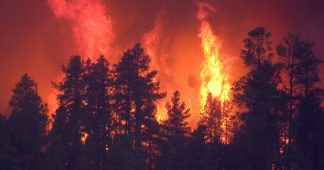John Davis
May 11, 2018
While Marx expected the industrial proletariat to spearhead the socialist revolution, it is now left to those who resist the burning of the last of the planet’s fossil fuel – which continues to engorge the hyper-capitalism of the early twenty-first century – to usher us into the gloaming: the dappled shadowland of Modernity’s long twilight where we begin to make living arrangements that fully recognize the critical symbioses of the human and nonhuman.
Citizens for Responsible Oil and Gas (CFROG.org) in Ventura County in Southern California is fighting big, medium and little oil as they rapaciously squeeze the last reserves of an oil-rich county by drilling, fracking, and even tar-sands extraction right in the middle of the Oxnard plain, one of the richest row-crop regions in the state. There is, at this point, no such-thing as responsible oil and gas. But as CROG’s executive director, Kimberly Rivers, explained to me, this milquetoast designation is necessary to maintain ‘a seat at the table’. This is a table that is sliding irrevocably into the trash-heap of history. But for now, attendance at the last supper of the depraved predation of the earth’s crust provides a few scraps of satisfaction in the reining in of the worst acts of malfeasance by the County and oil industry cabal.
CFROG are fighting oil interests on the basis of their bureaucratic over-reach facilitated by a County Planning Department long used to the laissez-faire, rubber-stamp continuance of long-ago conditional-use permits extended time and time again often covering new methods of monsterish extraction, flaring and waste-water re-injection without enforcing the terms of the California’s Environmental Quality Act – because the original permits pre-date the passing of the legislation signed into law by Ronald Reagan in 1970. Oil drilling, oil spills and resistance to the environmental damage they cause have a long history in Southern California.
Locally, in the foothills of the easterly spine of the Santa Ynez mountain range, interest in oil seeps began for Anglo-American settlers in 1854 when surface oil from Sulphur Mountain was collected and then refined for oil lamps. By the 1860’s, tunnels were dug into the folded oil-bearing seams of the hills and became, for that era, highly productive generating up to twenty barrels a day. They continued in production for almost a century and a half. The last Sulphur Mountain oil tunnel was only plugged and abandoned in 1997. Oil seeps continued to smoke for several months after the recent Thomas Fire which swept through western portions of the county.
The first commercially productive well in California was in Rancho Ojai just down the Ojai Road as it heads to Santa Paula alongside of Sisar creek and just north of the oil-seeping Sulphur Mountain. It was drilled to a depth of 550 feet in 1866 and produced fifteen to twenty barrels a day. That well was capped long ago, but to this day, CFROG continues to fight the oil companies who endanger local steelhead trout and other native fauna by drilling adjacent to Santa Paula creek, into which Sisar creek flows.
California’s first gusher was located close by in Adam’s Canyon which winds up from the Santa Clara flood plain a little west of State Highway 150 towards the Sulphur Mountain ridge. This blew in 1892 and 40,000 barrels ran down the canyon into the river below and were washed out to sea just south of Ventura harbor before it was capped. There were no video cameras to record the environmental damage and this, the first major oil spill in the United States, has passed quietly into History. In 1910 the greatest gusher of them all was unleashed in the Midway-Sunset field two miles north of Maricopa in Kern County which ran unchecked for eighteen months and spilled over eight million barrels.
In the County of Santa Barbara, north of Ventura, oil fields were discovered towards the end of the nineteenth century and in 1896 its first off-shore well was sunk off the small community of Summerland. The 1969 one-hundred-thousand barrel off-shore spill in the County’s Dos Cuadros field focused world-wide attention on the environmental havoc wrought by the pursuit of oil and is the event that spurred the creation of the first Earth Day, which arguably began the modern environmental movement.
Nearly fifty years later, we are no closer to containing either the rapacity of oil companies or the global warming impacts of the consumption of their products. Apparently, we are going to keep on grubbing for fossil fuels for as long as they remain the high density/low cost energy source. Global consumption has now moved past one hundred million barrels a day.
Along the transverse Tehachapi range which, in the 1940’s the socialist writer Carey McWilliams established as the northern boundary of Southern California, wind turbines stand magnificently in the grazed landscapes, like the ghost gums of Australia. They are not topped with a fringe of leaves like the antipodean arboreal giants but instead with great leafless branches stretched wide – their triple bladed rotors. In the vastness of the Mojave they have been positioned at its western fringe as it uplifts into the transverse range which guards the spine of Central California, John Muir’s High Sierras. Here, the turbines harvest the seemingly eternal on-shore winds that are funneled through the Tehachapi pass and their electrical power is then transmitted, substation to substation, to the dense populations of Greater Los Angeles.
This is what many wish that twenty-first century Modernity will look like: behemoth machines striding across damaged landscapes feeding energy hungry Americans accustomed to gorging on the all-you-can-eat buffet of cheap oil and gas. Now, wind power and large scale solar arrays provide a renewables side dish to further sate the appetite for the ease, comfort, personal transportation and media devices that define American lifestyles of over-consumption, all the while eroding the wild edges of their habitation. This is where the infrastructures for energy production – whether renewables or fossil fuels – have subsumed the landscape. Almost unnoticed beneath Tehachapi’s giant wind turbines, cattle continue to graze having long since effected plant-community type-conversion, from native Joshua tree woodland to Europeanized weedy pastures. The hunger of the electrical grid and of its meat-eating consumers are conjointly satisfied.
It is thus that wind, solar, hydro and geo-thermal power nourish engorged appetites for energy by means other than oil and gas, whilst continuing to contribute to the environmental blowback of Modernity. In California, forests of wind turbines, displacing native vegetation and solar panel arrays, shimmering like water in the desert, offer mirages of a benign future. But renewables feed the same hubristic leisure pursuits, industrial production, factory farming, urban sprawl, globalization and endless travel to which we have long become addicted and which now condemn us to live on a damaged planet.
As the editors Elaine Gan, Anna Tsing, Heather Swanson and Nils Bubandt write in their introduction to Arts of Living on a Damaged Planet, 2017, “living arrangements that took millions of years to put into place are being undone in the blink of eye”. Their prescription is to show us, in their collection of papers originally presented at a conference they convened in 2014 at the University of California, Santa Cruz, “how to pay better attention to overlaid arrangements of human and nonhuman living spaces”, so that we might stand up to “the constant barrage of messages asking us to forget – that is, to allow a few private owners and public officials with their eyes focused on short-term gains to pretend that environmental devastation does not exist”.
In Southern California, an inordinately rich mosaic of ecosystems, plant communities and culturally rich human settlements, it is getting ever harder to pretend ignorance of our damaged planet and harder still to believe that ending our addiction to oil, vital as it is, will resolve the terrestrial predation that is entangled within Modernity’s toxic amalgam of capitalist, imperialist, racist and hegemonic habits of violence and exploitation.
As ever, we begin with noticing.











